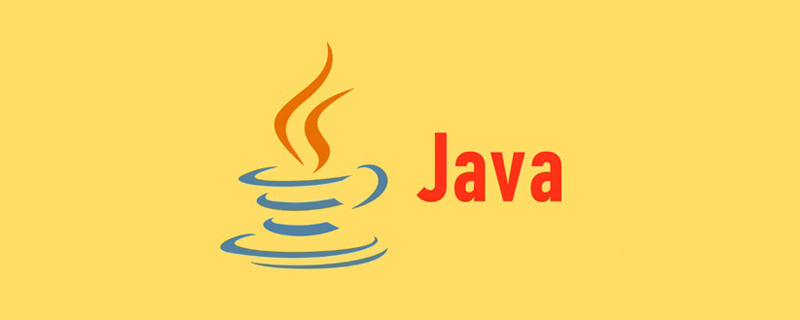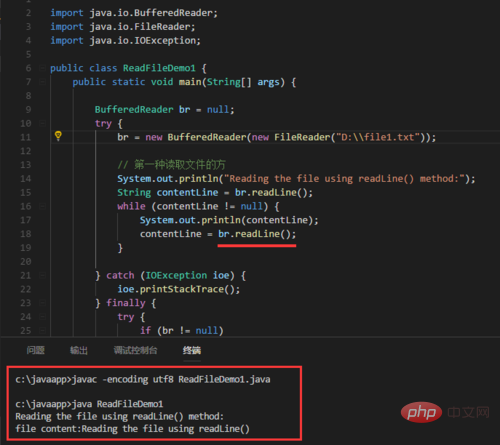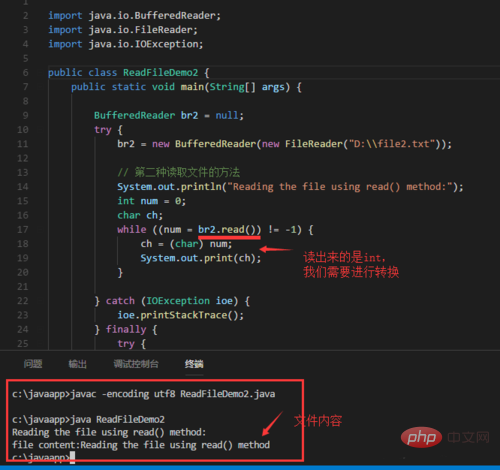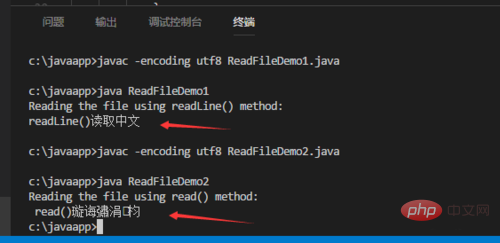How to read files in java?

Two classes can be used in java to read files: BufferedReader and BufferedInputStream.
1. Using BufferedReader
In the following examples, we will see two methods of using BufferedReader to read files.
Here, I have two txt files myfile1.txt and myfile2.txt. To demonstrate how to read a file.
I use the readLine() method to read the first file. Use the read() method to read the second file.
Method 1: Use the readLine () method of the BufferedReader class
public String readLine() throws IOException
It reads a line of text.

Method 2: Use read() method
public int read() throws IOException
It reads the characters of the text. Because it returns an integer value, it needs to be explicitly converted to type char.

2. Use BufferedInputStream
The steps to use FileInputStream and BufferedInputStream in java to read files are as follows:
1) Create a file instance by the full path of the file.
2) Pass the file instance to FileInputStream, which opens a connection to the actual file named by the file object file in the file system.
3) Pass the FileInputStream instance to BufferedInputStream, which creates a BufferedInputStream and saves its parameters in it for later use.
Create an internal buffer array in buf.
4) Use a while loop to read the file, and the available() method checks whether the end of the file has been read. Use the read function of FileInputStream in the while to read the file content
The complete code example is as follows
import java.io.*;
public class ReadFileDemo {
public static void main(String[] args) {
//读取c盘的file1文件
File file = new File("C://file1.txt");
BufferedInputStream bis = null;
FileInputStream fis= null;
try
{
//第一步 通过文件路径来创建文件实例
fis = new FileInputStream(file);
/*把FileInputStream实例 传递到 BufferedInputStream
目的是能快速读取文件
*/
bis = new BufferedInputStream(fis);
/*available检查是不是读到了文件末尾 */
while( bis.available() > 0 ){
System.out.print((char)bis.read());
}
}catch(FileNotFoundException fnfe)
{
System.out.println("文件不存在" + fnfe);
}
catch(IOException ioe)
{
System.out.println("I/O 错误: " + ioe);
}
finally
{
try{
if(bis != null && fis!=null)
{
fis.close();
bis.close();
}
}catch(IOException ioe)
{
System.out.println("关闭InputStream句柄错误: " + ioe);
}
}
}
}
Read Chinese
It is recommended to use readline instead of read to read, because Chinese read After reading and converting, it will become garbled characters.

php Chinese website, a large number of free Java introductory tutorials, welcome to learn online!
The above is the detailed content of How to read files in java?. For more information, please follow other related articles on the PHP Chinese website!

Hot AI Tools

Undresser.AI Undress
AI-powered app for creating realistic nude photos

AI Clothes Remover
Online AI tool for removing clothes from photos.

Undress AI Tool
Undress images for free

Clothoff.io
AI clothes remover

Video Face Swap
Swap faces in any video effortlessly with our completely free AI face swap tool!

Hot Article

Hot Tools

Notepad++7.3.1
Easy-to-use and free code editor

SublimeText3 Chinese version
Chinese version, very easy to use

Zend Studio 13.0.1
Powerful PHP integrated development environment

Dreamweaver CS6
Visual web development tools

SublimeText3 Mac version
God-level code editing software (SublimeText3)

Hot Topics
 Java Spring Interview Questions
Aug 30, 2024 pm 04:29 PM
Java Spring Interview Questions
Aug 30, 2024 pm 04:29 PM
In this article, we have kept the most asked Java Spring Interview Questions with their detailed answers. So that you can crack the interview.
 Break or return from Java 8 stream forEach?
Feb 07, 2025 pm 12:09 PM
Break or return from Java 8 stream forEach?
Feb 07, 2025 pm 12:09 PM
Java 8 introduces the Stream API, providing a powerful and expressive way to process data collections. However, a common question when using Stream is: How to break or return from a forEach operation? Traditional loops allow for early interruption or return, but Stream's forEach method does not directly support this method. This article will explain the reasons and explore alternative methods for implementing premature termination in Stream processing systems. Further reading: Java Stream API improvements Understand Stream forEach The forEach method is a terminal operation that performs one operation on each element in the Stream. Its design intention is
 PHP: A Key Language for Web Development
Apr 13, 2025 am 12:08 AM
PHP: A Key Language for Web Development
Apr 13, 2025 am 12:08 AM
PHP is a scripting language widely used on the server side, especially suitable for web development. 1.PHP can embed HTML, process HTTP requests and responses, and supports a variety of databases. 2.PHP is used to generate dynamic web content, process form data, access databases, etc., with strong community support and open source resources. 3. PHP is an interpreted language, and the execution process includes lexical analysis, grammatical analysis, compilation and execution. 4.PHP can be combined with MySQL for advanced applications such as user registration systems. 5. When debugging PHP, you can use functions such as error_reporting() and var_dump(). 6. Optimize PHP code to use caching mechanisms, optimize database queries and use built-in functions. 7
 PHP vs. Python: Understanding the Differences
Apr 11, 2025 am 12:15 AM
PHP vs. Python: Understanding the Differences
Apr 11, 2025 am 12:15 AM
PHP and Python each have their own advantages, and the choice should be based on project requirements. 1.PHP is suitable for web development, with simple syntax and high execution efficiency. 2. Python is suitable for data science and machine learning, with concise syntax and rich libraries.
 Java Program to Find the Volume of Capsule
Feb 07, 2025 am 11:37 AM
Java Program to Find the Volume of Capsule
Feb 07, 2025 am 11:37 AM
Capsules are three-dimensional geometric figures, composed of a cylinder and a hemisphere at both ends. The volume of the capsule can be calculated by adding the volume of the cylinder and the volume of the hemisphere at both ends. This tutorial will discuss how to calculate the volume of a given capsule in Java using different methods. Capsule volume formula The formula for capsule volume is as follows: Capsule volume = Cylindrical volume Volume Two hemisphere volume in, r: The radius of the hemisphere. h: The height of the cylinder (excluding the hemisphere). Example 1 enter Radius = 5 units Height = 10 units Output Volume = 1570.8 cubic units explain Calculate volume using formula: Volume = π × r2 × h (4
 PHP vs. Other Languages: A Comparison
Apr 13, 2025 am 12:19 AM
PHP vs. Other Languages: A Comparison
Apr 13, 2025 am 12:19 AM
PHP is suitable for web development, especially in rapid development and processing dynamic content, but is not good at data science and enterprise-level applications. Compared with Python, PHP has more advantages in web development, but is not as good as Python in the field of data science; compared with Java, PHP performs worse in enterprise-level applications, but is more flexible in web development; compared with JavaScript, PHP is more concise in back-end development, but is not as good as JavaScript in front-end development.
 PHP vs. Python: Core Features and Functionality
Apr 13, 2025 am 12:16 AM
PHP vs. Python: Core Features and Functionality
Apr 13, 2025 am 12:16 AM
PHP and Python each have their own advantages and are suitable for different scenarios. 1.PHP is suitable for web development and provides built-in web servers and rich function libraries. 2. Python is suitable for data science and machine learning, with concise syntax and a powerful standard library. When choosing, it should be decided based on project requirements.
 Create the Future: Java Programming for Absolute Beginners
Oct 13, 2024 pm 01:32 PM
Create the Future: Java Programming for Absolute Beginners
Oct 13, 2024 pm 01:32 PM
Java is a popular programming language that can be learned by both beginners and experienced developers. This tutorial starts with basic concepts and progresses through advanced topics. After installing the Java Development Kit, you can practice programming by creating a simple "Hello, World!" program. After you understand the code, use the command prompt to compile and run the program, and "Hello, World!" will be output on the console. Learning Java starts your programming journey, and as your mastery deepens, you can create more complex applications.






